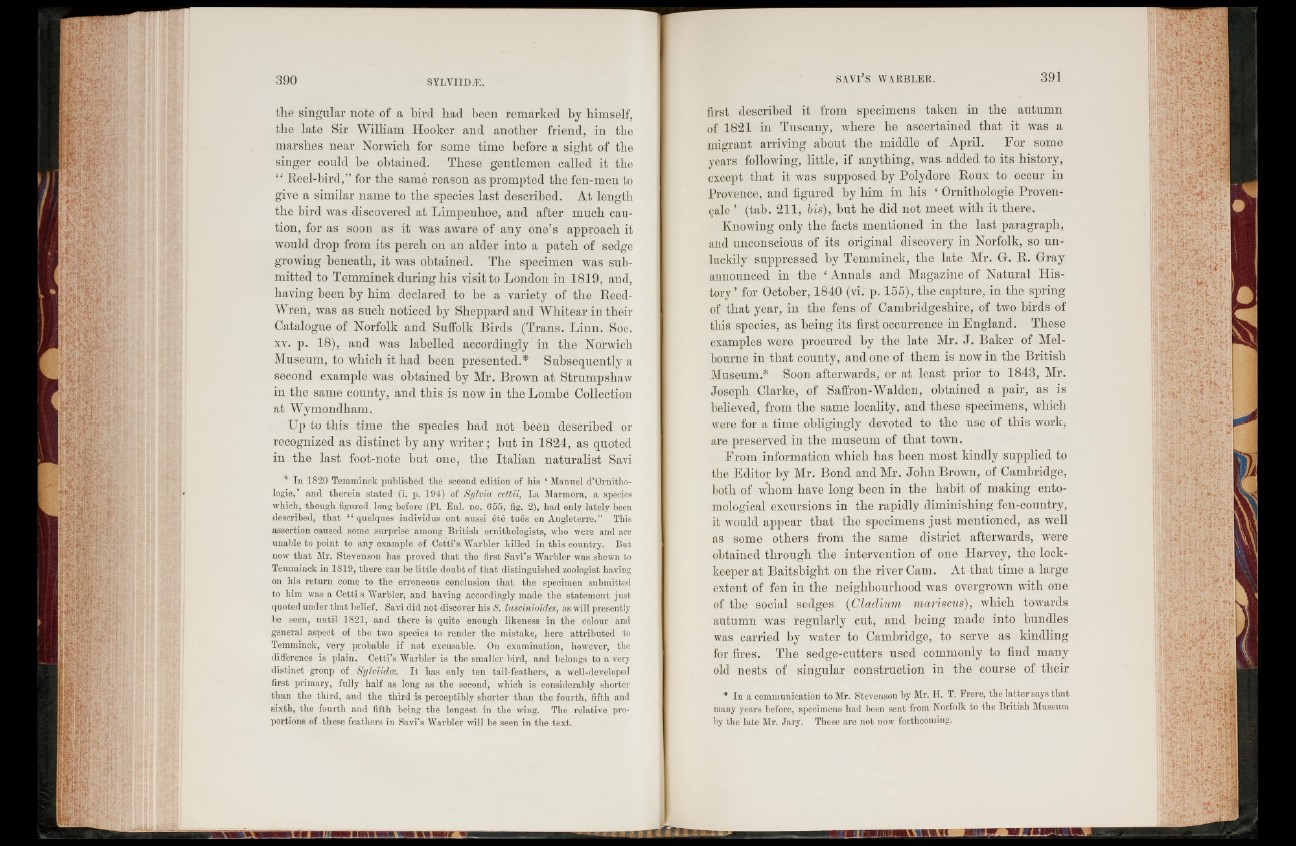
the singular note of a bird had been remarked by himself,
the late Sir William Hooker and another friend, in the
marshes near Norwich for some time before a sight of the
singer could he obtained. These gentlemen called it the
“ Reel-bird,” for the samé reason as prompted the fen-men to
give a similar name to the species last described. At length
the bird was discovered at Limpenhoe, and after much caution,
for as soon as it was aware of any one’s approach it
would drop from its perch on an alder into a patch of sedge
growing beneath, it was obtained. The specimen was submitted
to Temminck during his visit to London in 1819, and,
having been by him declared to be a variety of the Reed-
W ren, was as such noticed by Sheppard and Whitear in their
Catalogue of Norfolk and Suffolk Birds (Trans. Linn. Soc.
xv. p. 18), and was labelled accordingly in the Norwich
Museum, to which it had been presented.* Subsequently a
second example was obtained by Mr. Brown at Strumpshaw
in the same county, and this is now in the Lomhe Collection
at Wymondham.
Up to this time the species had not been described or
recognized as distinct by any writer; but in 1824, as quoted
in the last foot-note but one, the Italian naturalist Savi
* In 1820 Temminck published the second edition of his ‘Manuel d’Ornitho-
logie, ’ and therein stated (i. p. 194) of Sylvia cettii, La Marmora, a species
which, though figured long before (FI. Enl. no. 655, fig. 2), had only lately been
described, that “ quelques individus ont aussi été tués en Angleterre.” This
assertion caused some surprise among British ornithologists, who were and are
unable to point to any example of Cetti’s Warbler killed in this country. But
now that Mr. Stevenson has proved that the first Savi’s Warbler was shewn to
Temminck in 1819, there can be little doubt of that distinguished zoologist having
on his return come to the erroneous conclusion that the specimen submitted
to him was a Cetti s Warbler, and having accordingly made the statement just
quoted under that belief. Savi did not discover his S. Inscinioides, a swill presently
be seen, until 1821, and there is quite enough likeness in the colour and
general aspect of the two species to render the mistake, here attributed to
Temminck, very probable if not excusable. On examination, however, the
difference is plain. Cetti’s Warbler is the smaller bird, and belongs to a very
distinct group of Sylviidce. I t has only ten tail-feathers, a well-developed
first primary, fully half as long as the second, which is considerably shorter
than the third, and the third is perceptibly shorter than the fourth, fifth and
sixth, the fourth and fifth being the longest in the wing. The relative proportions
of these feathers in Savi’s Warbler will be seen in the text.
first described it from specimens taken in the autumn
of 1821 in Tuscany, where he ascertained that it was a
migrant arriving about the middle of April. For some
years following, little, if anything, was. added to its history,
except that it was supposed by Polydore Roux to occur in
Provence, and figured by him in his ‘ Ornithologie Provençale
’ (tab. 211, bis), but he did not meet with it there.
Knowing only the facts mentioned in the last paragraph,
and unconscious of its original discovery in Norfolk, so unluckily
suppressed by Temminck, the late Mr. G. R. Gray
announced in the ‘ Annals and Magazine of Natural History
’ for October, 1840 (vi. p. 155), the capture, in the spring
of that year, in the fens of Cambridgeshire, of two birds of
this species, as being its first occurrence in England. These
examples were procured by the late Mr. J. Baker of Melbourne
in that county, and one of them is now in the British
Museum.* Soon afterwards, or at least prior to 1843, Mr.
Joseph Clarke, of Saffron-Walden, obtained a pair, as is
believed, from the same locality, and these specimens, which
were for a time obligingly devoted to the use of this work,
are preserved in the museum of that town.
From information which lias been most kindly supplied to
the Editor by Mr. Bond and Mr. John Brown, of Cambridge,
both of whom have long been in the habit of making entomological
excursions in the rapidly diminishing fen-country,
it would appear that the specimens just mentioned, as well
as some others from the same district afterwards, were
obtained through the intervention of one Harvey, the lock-
keeper at Baitsbiglit on the river Cam. At that time a large
extent of fen in the neighbourhood was overgrown with one
of the social sedges (Cladium mariscus), which towards
autumn was regularly cut, and being made into bundles
was carried by water to Cambridge, to serve as kindling
for fires. The sedge-cutters used commonly to find many
old nests of singular construction in the course of their
* In a communication to Air. Stevenson by Mr. H. T. Frere, the latter says that
many years before, specimens had been sent from Norfolk to the British Museum
by the late Mr. Jary. These are not now forthcoming.